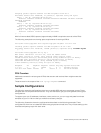
To use soft reconfiguration (or soft reset) without preconfiguration, both BGP peers must support the soft
route refresh capability, which is advertised in the open message sent when the peers establish a TCP
session.
To determine whether a BGP router supports this capability, use the show ip bgp neighbors
command. If a router supports the route refresh capability, the following message displays: Received
route refresh capability from peer.
If you specify a BGP peer group by using the peer-group-name argument, all members of the peer
group inherit the characteristic configured with this command.
• Clear all information or only specific details.
EXEC Privilege mode
clear ip bgp {* | neighbor-address | AS Numbers | ipv4 | peer-group-name}
[soft [in | out]]
– *: Clears all peers.
– neighbor-address: Clears the neighbor with this IP address.
– AS Numbers: Peers’ AS numbers to be cleared.
– ipv4: Clears information for the IPv4 address family.
– peer-group-name: Clears all members of the specified peer group.
• Enable soft-reconfiguration for the BGP neighbor specified.
CONFIG-ROUTER-BGP mode
neighbor {ip-address | peer-group-name} soft-reconfiguration inbound
BGP stores all the updates received by the neighbor but does not reset the peer-session.
Entering this command starts the storage of updates, which is required to do inbound soft
reconfiguration. Outbound BGP soft reconfiguration does not require inbound soft reconfiguration to
be enabled.
Example of Soft-Reconfigration of a BGP Neighbor
The example enables inbound soft reconfiguration for the neighbor 10.108.1.1. All updates received from
this neighbor are stored unmodified, regardless of the inbound policy. When inbound soft reconfiguration
is done later, the stored information is used to generate a new set of inbound updates.
Dell>router bgp 100
neighbor 10.108.1.1 remote-as 200
neighbor 10.108.1.1 soft-reconfiguration inbound
Route Map Continue
The BGP route map continue feature, continue [sequence-number], (in ROUTE-MAP mode) allows
movement from one route-map entry to a specific route-map entry (the sequence number).
If you do not specify a sequence number, the continue feature moves to the next sequence number (also
known as an “implied continue”). If a match clause exists, the continue feature executes only after a
successful match occurs. If there are no successful matches, continue is ignored.
Border Gateway Protocol IPv4 (BGPv4)
201


















